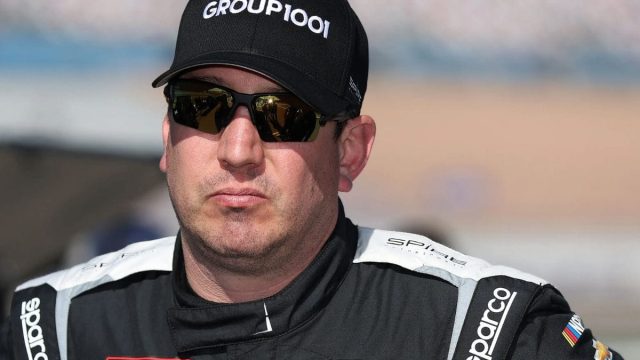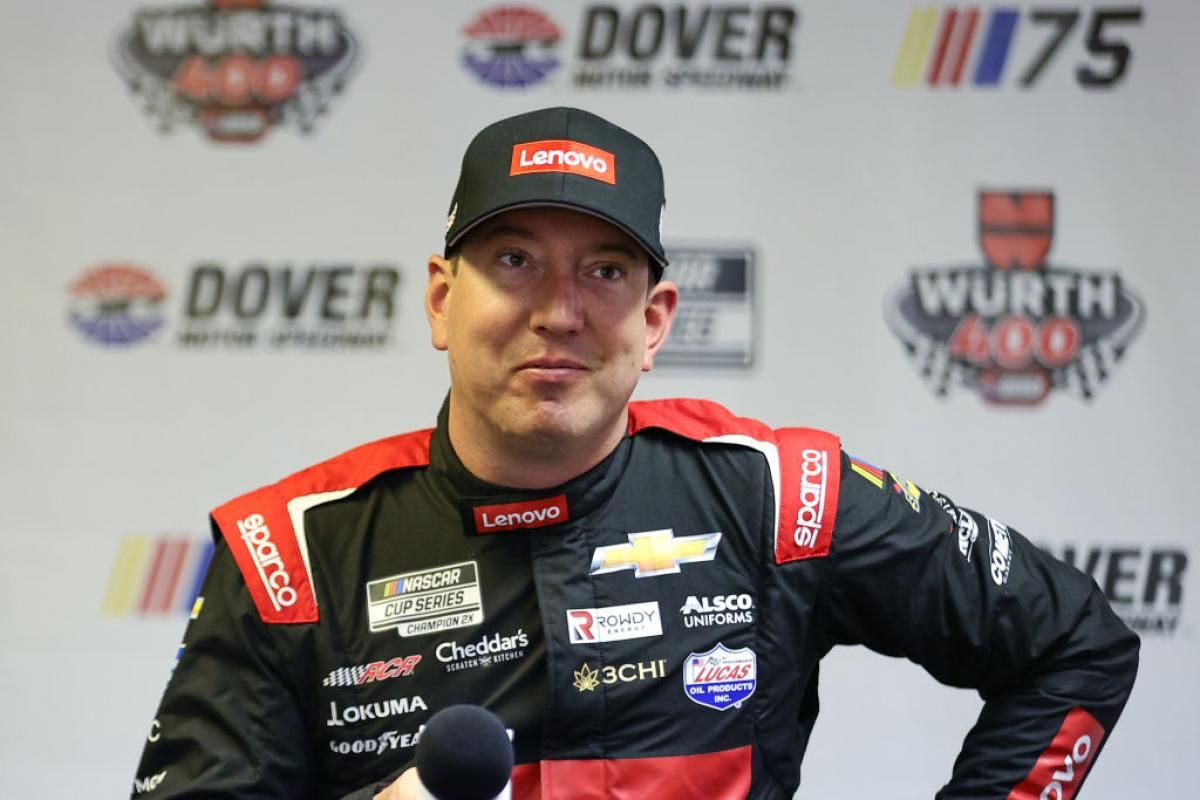Kevin Harvick Criticizes Kyle Busch’s Driving: Kyle Busch‘s aggressive driving style has long been a point of dispute within the NASCAR community, but his recent performance at the Indianapolis race has reignited this debate, especially following Kevin Harvick‘s pointed criticisms. Harvick’s comments, which highlighted the collision with Denny Hamlin and its broader implications for driver safety and race strategy, raise questions about the balance between competitiveness and responsibility on the track. As the stakes heighten in the playoff season, the consequences of Busch’s approach may extend far beyond this single incident, prompting a closer examination of the evolving dynamics in NASCAR.
Key Highlights
- Kevin Harvick criticized Kyle Busch’s aggressive driving style, stating it led to critical errors that threatened his race and playoff chances.
- Busch’s collision with Denny Hamlin showed poor risk assessment and highlighted the consequences of prioritizing aggressive tactics over strategic decision-making.
- Busch’s recent P25 finish at Indianapolis marked a significant missed opportunity, leaving him 29 points behind the playoff cutline.
- Harvick emphasized the necessity for veterans like Busch to practice more patience and accountability to ensure overall safety on the track.
Kyle Busch’s Misfortune at Indianapolis
Kyle Busch’s return to the Indianapolis Motor Speedway, a venue previously marked by his victories, turned into a striking disappointment as his tactical missteps ultimately weakened his performance in the latest Cup Series race of Brickyard 400.
Once a track where he highlighted his skill, Busch’s re-entrance revealed vulnerabilities that had not been apparent in his storied past. The two-and-a-half-mile oval, revered for its challenging layout and rich history, served as a stage for the highs and lows of competitive racing.
In the race, Busch’s aggressive driving style, while often a hallmark of his success, proved counterproductive. His attempts to stretch the limits of the track led to critical errors, resulting in lost positions and missed opportunities.
It’s evident that the decision-making process during high-pressure moments faltered, reflecting a broader issue that has ruined his 2024 season: inconsistency. The psychological toll of past setbacks may have also influenced his judgment, as he struggled to reconcile ambition with execution.
Moreover, the competitive landscape at Indianapolis has evolved, with other drivers capitalizing on tactical advantages. Busch’s failure to adapt to these shifts emphasized the necessity for continual assessment and refinement of racing techniques.
Kyle Busch’s Collision with Denny Hamlin
In a vital moment during the race, Busch’s ill-fated attempt to drive past Denny Hamlin showed a miscalculation that not only threatened his position but also emphasized the broader issues ruining his competitive strategy. As the laps dwindled, Busch, who was previously contending for a top-five finish, sought to exploit a narrow opening to overtake Hamlin. This low-percentage move was representative of Busch’s aggressive driving style, yet it ultimately proved detrimental.
The decision to attempt a pass in such significant circumstances raises questions about risk assessment in racing. While Busch’s instincts as a driver often push him to capitalize on opportunities, this incident highlights a tendency to prioritize aggressive tactics over calculated strategy. As he attempted to thread the needle, the result was catastrophic—Busch wrecked himself, finishing the race in 25th place, a glaring contrast to the potential success he could have attained.
Moreover, this incident serves as a cautionary tale regarding the importance of situational awareness. While some may contend that Hamlin’s racing tactics played a role in the collision, the primary responsibility rests with Busch. His choice to engage in such a risky action, especially when positioned well for a strong finish, shows a fundamental misjudgment.
The Aftermath and Harvick’s Comments
The aftermath of Busch’s collision not only marked a disappointing milestone in his career but also drew sharp criticism from fellow driver Kevin Harvick, who highlighted the implications of Busch’s reckless driving decision. Harvick’s comments reflect a growing concern within the NASCAR community regarding Busch’s aggressive approach, particularly in intense situations.
“This is a loaded scenario because I feel like Kyle is driving way over his head … He’s been in some scenarios where it hasn’t been his fault, but this one is 100 percent on him. With the car that they ran in back with part of the day but wound up making in the front making a pass inside the top five.” – (harvick)
Harvick noted that Busch’s desire to secure a top-five position led him to make risky tactics that ultimately backfired, emphasizing a critical gap in risk assessment during critical race moments.
Harvick’s assertion that the incident was ‘100 percent on him’ highlights the importance of owning one’s mistakes in competitive environments, a principle that resonates deeply within motorsports culture.
This collision is not an isolated incident; it reflects a pattern of aggressive driving that has often resulted in negative outcomes for Busch, raising questions about his tactical decision-making.
Points and Playoff Implications
Securing a strong finish is vital for Busch as he finds himself 29 points adrift of the playoff cutline, highlighting the urgency of maximizing each race’s potential in the final stretch of the regular season. The stakes could not be higher, with only four races remaining to earn important points. A top-five or even a top-10 finish is imperative to close the gap on the current 16th-place driver in the standings. Unfortunately, his recent P25 finish at Indianapolis shows a missed opportunity.
“You gotta finish those; you gotta get those to the start-finish line and finish those days to stop the bleeding. Because right now, I mean he’s bleeding from every direction you can bleed from and I think in some of the situations, you just gotta take a deep breath and maybe let’s finish fifth instead of fourth or instead of third.” – (harvick)
The implications of Busch’s current standing are profound, not just for his aspirations but for the overall dynamics of the playoff picture. Each race now serves as a vital battleground where every point counts. As Kevin Harvick astutely noted, ‘You gotta finish those; you gotta get those to the start-finish line.’ This statement represents the necessity of consistency over aggressive actions that could lead to further setbacks.
Busch’s performance must shift towards a more calculated approach, where securing finishes is prioritized over risky overtakes that may not yield the desired results. The road ahead requires a balance between aggressive racing and tactical caution.
Kyle Busch Apologizes for His Indianapolis Incident
Acknowledging the gravity of his recent misstep at the Brickyard 400, Kyle Busch expressed genuine remorse for his actions, which not only threatened his race but also put his team’s playoff aspirations at risk.
In a heartfelt apology shared via his X account, Busch took full responsibility for the crash that unraveled what could have been a solid finish for the RCR team. His acknowledgment of a notable blunder reflects a deeper understanding of the competitive stakes involved.
“Got right where we wanted to b w a good car and some really good pit calls. I’m really sorry to all my guys and RCR for crashing while trying to b aggressive and get them a top 5 finish. Ready for this two wk break. Really need it.” – (busch)
Got right where we wanted to b w a good car and some really good pit calls. I’m really sorry to all my guys and RCR for crashing while trying to b aggressive and get them a top 5 finish. Ready for this two wk break. Really need it.@RCRracing x @cheddarskitchen pic.twitter.com/YT8D5hYogp
— Kyle Busch (@KyleBusch) July 21, 2024
Rebuilding confidence among team members after a setback is vital. A united front could enhance their performance. Learning from past mistakes, particularly in intense situations, will be fundamental in optimizing race strategies.
Striking the right balance between aggressive driving and tactical caution can determine success in the remaining races. The upcoming two-week break presents an opportunity for Busch to reassess his mindset and approach, focusing on resilience and resolve.
With just five races left in the regular season, the possibility of a turnaround remains. A victory could not only salvage the season but also restore faith in Busch and the RCR team.
News in Brief: Kevin Harvick Criticizes Kyle Busch’s Driving
The criticisms directed at Kyle Busch following the Indianapolis race highlight an essential intersection of strategy and safety within NASCAR. The collision with Denny Hamlin serves as a reminder of the potential consequences of impulsive driving behaviors in intense situations.
Kevin Harvick’s emphasis on patience and accountability emphasizes the need for drivers to prioritize calculated decision-making. As Busch goes through the aftermath, the implications for his performance and playoff aspirations remain substantial, prompting a necessary reevaluation of racing tactics.
ALSO READ: Kyle Busch Praises Kyle Larson’s Skills: “Kyle Is Probably One of the Best”



